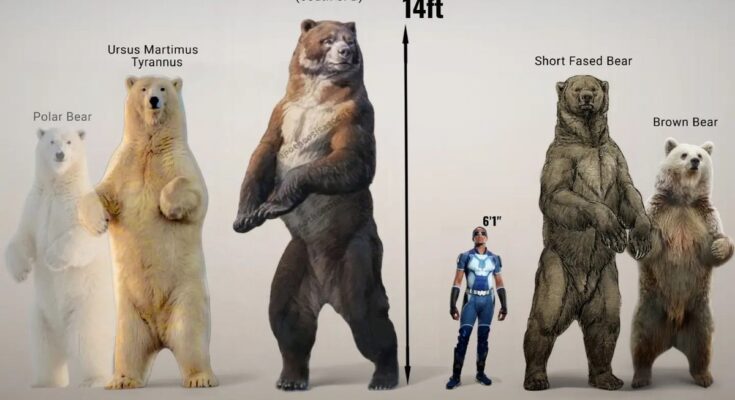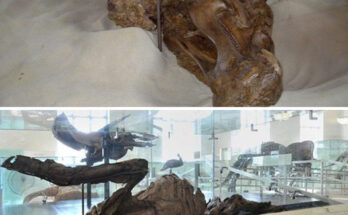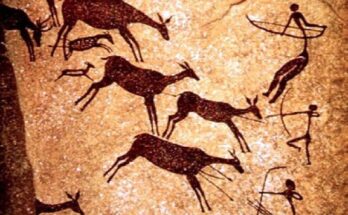Bear Size Comparison: A Fascinating Look at Nature’s Giants
When it comes to the animal kingdom, few creatures command respect and awe quite like bears. Their imposing size, strength, and diverse habitats make them a subject of fascination for wildlife enthusiasts and researchers alike. In this detailed size comparison, we explore five remarkable bear species, showcasing their heights and weights to give you a comprehensive understanding of these majestic animals. The image, credited to @apotheosisascent, provides a striking visual representation of how these bears stack up against a human figure standing at 6’1″.

Polar Bear (Ursus Maritimus)
Starting with the polar bear, known scientifically as Ursus maritimus, we encounter one of the most iconic inhabitants of the Arctic. This species is depicted on the far left of the image, standing tall with its signature white fur. Polar bears typically range in height from about 7 to 10 feet when standing on their hind legs, though their average weight spans between 450 and 1000 kilograms (990 to 2200 pounds). The males are significantly larger than the females, with some reaching up to 10 feet in length and weighing as much as a ton. Their robust build is perfectly adapted for life on the ice, where they hunt seals and navigate frigid waters.
Tyrannus Polar Bear
Next to the polar bear is the Tyrannus polar bear, a variant that appears slightly larger and more robust in this illustration. Weighing between 500 and 1200 kilograms (1100 to 2650 pounds), this subspecies or depiction suggests a formidable presence. Standing approximately 8 to 11 feet tall when upright, the Tyrannus polar bear showcases a thicker fur coat and a more muscular frame, hinting at adaptations for harsher conditions or a unique evolutionary path. This bear’s size makes it a standout, even among other polar bear populations.
Arctotherium (South SF Bear)
Dominating the center of the image is the Arctotherium, often referred to as the South American short-faced bear (South SF Bear). This extinct species, once roaming the prehistoric landscapes of South America, is the tallest bear in this comparison, reaching an impressive 14 feet when standing. Its weight is estimated to range from 1588 to 1750 kilograms (3500 to 3850 pounds), making it one of the largest bear species ever known. The Arctotherium’s massive stature, as illustrated, dwarfs the human figure and highlights its role as a top predator in its ecosystem millions of years ago. Its robust limbs and powerful jaws suggest it was capable of taking down large prey with ease.
Short-Faced Bear
To the right of the Arctotherium is the short-faced bear, a species that, despite its name, still presents an imposing figure. Standing around 9 to 11 feet tall when upright, this bear weighs between 900 and 1100 kilograms (2000 to 2400 pounds). Its shorter snout, as the name implies, distinguishes it from other bears, and its build suggests a mix of speed and strength. This species, likely a representation of the North American short-faced bear (Arctodus), was a formidable carnivore, capable of covering vast distances in search of food during the Pleistocene epoch.
Brown Bear
Rounding out the comparison is the brown bear, a familiar sight in North America, Europe, and Asia. Positioned on the far right, the brown bear stands about 7 to 9 feet tall when on its hind legs, with weights ranging from 250 to 780 kilograms (550 to 1720 pounds). The males are notably larger than the females, and their size can vary depending on their habitat—coastal populations, like the Kodiak bear, tend to be heavier due to a diet rich in salmon. The brown bear’s versatile physique allows it to thrive in diverse environments, from dense forests to open tundras.
Human Perspective
For scale, the image includes a human figure standing at 6’1″ (approximately 1.85 meters), clad in a blue suit. This provides a relatable benchmark, emphasizing the sheer magnitude of these bears. The polar bear and Tyrannus polar bear tower over the human, while the Arctotherium and short-faced bear loom even more impressively. The brown bear, though smaller in comparison, still presents a significant size difference, underscoring the dominance of bears in the natural world.
Conclusion
This size comparison offers a captivating glimpse into the diversity and grandeur of bear species, both extant and extinct. From the Arctic-dwelling polar bear to the prehistoric giant Arctotherium, each bear showcases unique adaptations that have allowed them to thrive in their respective environments. Whether you’re marveling at the polar bear’s icy prowess or the Arctotherium’s ancient might, this visual guide highlights why bears remain some of nature’s most awe-inspiring creatures. Special thanks to @apotheosisascent for creating this detailed and informative illustration, which brings these comparisons to life.
Explore more about these incredible animals and their habitats, and let us know your favorite bear species in the comments below!



